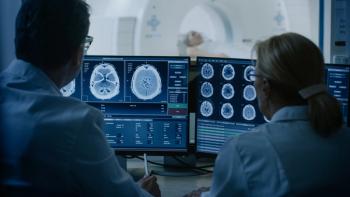
Targeted Therapies Transform CLL Care: Inside the Era of BTK and BCL2 Inhibitors
Key Takeaways
- CLL management focuses on symptom control, extending progression-free survival, and improving quality of life with targeted therapies like BTK and BCL2 inhibitors.
- Genetic mutations, such as 17p deletion and IGHV mutation, are critical in determining treatment strategies and prognosis in CLL.
Explore the latest advancements in chronic lymphocytic leukemia treatment, focusing on BTK and BCL2 inhibitors, monoclonal antibodies, and patient management strategies.
Chronic lymphocytic leukemia (CLL) is an incurable but relatively manageable leukemia with a 5-year overall survival exceeding 90% with modern treatments such as monoclonal antibodies (mAbs), Bruton tyrosine kinase (BTK) inhibitors, and BCL2 inhibitors, which have revolutionized outcomes for patients with CLL. Experts at the Community Oncology Alliance 2025 Community Oncology Conference discussed the treatment of CLL with BTK and BCL2 inhibitors, focusing on key points including the following: the importance of patient selection based on genetic mutations; current treatment options with emphasis on their efficacy and adverse effects (AEs); and the role of pharmacists in managing these therapies.
CLL is a slow-growing leukemia characterized by gradual accumulation of abnormal B cells in blood, bone marrow, and lymph nodes, which eventually requires treatment. In some cases, patients can be on a "watch and wait" protocol before needing intervention. CLL is incurable, so treatment is focused on management of symptoms, extending progression-free survival (PFS), improving quality of life, and controlling disease progression. Contemporary standard of care therapies include mAbs or targeted therapies, such as BTK and BCL2 inhibitors, which can be used in combination and personalized based on a patient’s genetic profile and overall health.
In CLL, deletion of 17p and mutated Immunoglobulin Heavy Chain Variable (IGHV) region are key genetic mutations critical for determining treatment selection, disease progression, treatment response, and therapy approach. Deletion 17p mutation involves deletion of TP53 tumor suppressor gene and is considered a poor prognostic marker indicating more aggressive disease. This mutation is characterized by shorter remission periods requiring novel targeted therapies and more aggressive treatment strategies. Alternatively, IGHV is a positive prognostic factor indicating slower disease progression and longer time to next therapy, suggesting the potential for less aggressive approaches.
Identifying the presence of these mutations will drive treatment decisions; for example, patients with 17p deletions are recommended to be treated with zanubrutinib (Brukinsa; Beigene), venetoclax (Vexclexta; AbbVie and Genentech) with obinutuzumab (Gazyva; Genentech), or the triple combination of acalabrutinib (Calquence; AstraZeneca), venetoclax, and obinutuzumab. It is not advised to treat these patients with traditional chemotherapy, ibrutinib (Imbruvica; Janssen Biotech), single-agent venetoclax, or bendamustine (Bendeka; Teva Pharmaceuticals) and rituximab (Rituxan; Genentech). Patients with IGHV mutations, however, may have more flexible treatment options due to less aggressive disease.
Among the key components of many treatment regimens are anti-CD20 monoclonal antibodies, such as rituximab, rituximab biosimilars, and obinutuzumab. These agents target the CD20 receptor expressed on nearly all CLL cells and play a central role in both frontline and relapsed/refractory treatment strategies. By binding to the receptor, mAbs can drive cell death through direct cell death, antibody-dependent cellular cytotoxicity, and complement-dependent cytotoxicity. They are often used in combination therapies to enhance the effectiveness of other treatments. Although anti-CD20 mAbs are effective for most patients with CLL, they are associated with infusion-related reactions, increased infection risk, and potential immune system suppression.
BTK inhibitors are another essential drug class in CLL treatment. These agents block BTK enzyme intracellularly, interrupting signaling pathways and preventing cancer cell survival. There are 3 generations of these drugs, each with varying toxicity levels and clinical benefits. The first-generation BTK inhibitor is ibrutinib, which was the pioneer for BTK inhibitors. However, it is associated with more AEs compared with second- and third-generation drugs. Second-generation BTK inhibitors, such as acalabrutinib and zanabrutinib, offer improved potency and a more favorable safety profile compared with first-generation agents. The third-generation BTK inhibitor pirtobrutinib (Jaypirca; Eli Lilly and Company), a noncovalent and reversible agent, is designed to overcome resistance to earlier BTK inhibitors, including those caused by mutations in the BTK binding site.
BTK inhibitor therapy offers several advantages in the treatment of CLL, including continuous dosing, improved PFS, and targeted activity that is effective across multiple genetic profiles. However, despite their benefits, BTK inhibitors are associated with a range of AEs. These include bleeding events (with grade 3 to 4 events occurring in approximately 3%-4% of patients), cardiac arrhythmias (eg, atrial fibrillation, hypertension, infections, neutropenia), and musculoskeletal symptoms like muscle or joint pain.
“Looking at the rates of bleeding, anywhere from a third to 40% of patients might have some type of bleeding,” explained Kirollos Hanna, PharmD, BCPS, BCOP, FACCC, FAPO, director of pharmacy at Minnesota Oncology and assistant professor of pharmacy at the Mayo Clinic College of Medicine. “Most of the bleeding events tend to be in grades 1 and 2.”
The development of BCL2 inhibitors, namely venetoclax, represents a novel advancement in CLL therapy. Unlike BTK inhibitors, which work intracellularly to block signaling pathways that promote cell survival, BCL2 inhibitors cause apoptosis by directly targeting and inhibiting the BCL2 protein. These agents can be used in both frontline and relapsed/refractory settings and are often combined with obinutuzumab. Although there are advantages, such as the option for a fixed-duration treatment course of one year, BCL2 inhibitors come with unique considerations. The risk of tumor lysis syndrome (TLS) necessitates a careful dose ramp-up and intensive initial monitoring. Additionally, treatment initiation can be complex, involving high upfront costs, significant logistical planning, and close coordination between care teams to ensure patient safety during the early phases of therapy.
“So that would be very attractive to a patient who is motivated to get off therapy quickly, but that one year is going to be fairly intense in terms of lab monitoring for some of the adverse effects,” said Karen Fancher, PharmD, BCOP, associate professor of Pharmacy Practice at Duquesne University School of Pharmacy in Pittsburgh, Pennsylvania. “There would be a high upfront cost. There's going to be a lot of logistics to get obinutuzumab in the clinic. So, these are things we would discuss with both the medical team and the patient before we selected any of this therapy.”
Patient selection plays a critical role in optimizing outcomes for individuals with CLL and should be guided by the patient's genetic profile—such as the presence of high-risk mutations—as well as comorbid conditions and individual goals of care. Understanding and anticipating potential adverse events is also essential, particularly when selecting between therapies like BTK inhibitors and BCL2 inhibitors, which differ in toxicity profiles and administration strategies.
“So, it’s going to be very important for us to understand our patients at baseline,” said Hanna. “If your patient comes to you at baseline with preexisting cardiac arrhythmias, it’s not necessarily a contraindication to put them on a BTK inhibitor, right? It might, however, make BCL2 therapy a little bit more attractive.”
When managing patients who relapse or are refractory to initial treatment, sequencing of therapies becomes a key consideration. For those experiencing issues with BTK inhibitors, it is important to determine whether the difficulty is due to drug intolerance or progressive disease, as this will guide the next line of therapy. Similarly, for patients who relapse after treatment with venetoclax, pharmacists must assess whether the relapse occurred during active treatment or after its completion, as this distinction influences subsequent therapeutic options.
Pharmacists play a crucial role in the treatment of CLL by managing oral oncolytic therapies, monitoring adverse effects from BTK and BCL2 inhibitors, and supporting medication therapy management. They assist in treatment selection, ensure adherence to complex regimens, and provide patient education on medication administration, potential adverse effects, and adherence strategies. Pharmacists also collaborate with the health care team, help with financial navigation, and coordinate access to therapies, contributing to a holistic approach to patient care.
Evidence-based studies highlight the significant impact of pharmacist-managed programs, showing reductions in grade 3 to 4 adverse events, improved PFS, and enhanced patient adherence. Emerging opportunities for pharmacists include potential billing for specialized services, integration into medically integrated pharmacy models, and an expanding role in oral oncology management. Overall, pharmacists offer invaluable expertise in medication management, providing patient-centered care and acting as a critical link between the patient and the treatment team.
As treatment strategies for CLL continue to evolve, the integration of targeted therapies such as BTK and BCL2 inhibitors has transformed outcomes, offering patients more personalized and effective care options. However, the complexity of these regimens demands thoughtful patient selection, close monitoring, and multidisciplinary collaboration. Pharmacists play a pivotal role in this landscape—bridging the gap between clinical teams and patients through medication management, education, and adherence support. As innovation continues and roles expand, pharmacists remain central to optimizing outcomes and delivering comprehensive, patient-centered care in CLL.
REFERENCE
Fancher K, Hanna K. Advancing Chronic Lymphocytic Leukemia Treatment in the Community: Practical Updates & Clinical Pearls for Oncology Pharmacists. Community Oncology Alliance 2025 Community Oncology Conference; April 29-30, 2025; Orlando, FL.
Newsletter
Stay informed on drug updates, treatment guidelines, and pharmacy practice trends—subscribe to Pharmacy Times for weekly clinical insights.


















































































































































































































